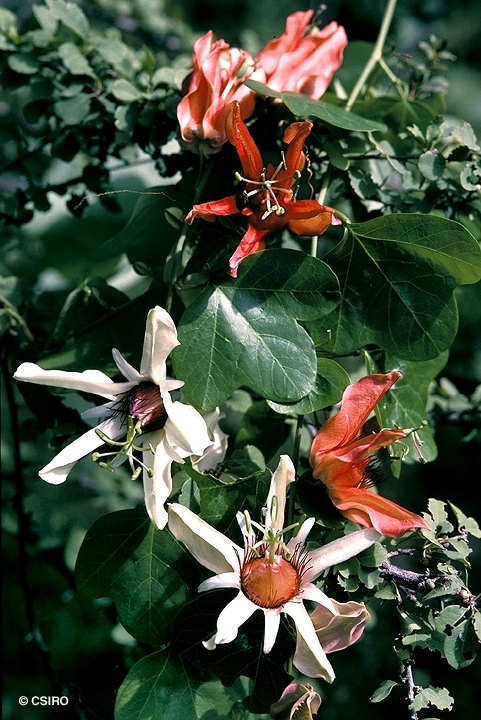Australian Tropical Rainforest Plants - Online edition
Passiflora aurantia G.Forst. var. aurantia
Bailey, F.M. (1911) Queensland Agricultural Journal 26: 315.
Blunt-leaved Passionfruit; Red Passion Flower
A slender vine not exceeding a stem diameter of 2 cm.
Leaf blades deeply 3-lobed, blades about 3-7.5 x 4.5-8 cm, petioles about 1.5-4 cm long with two(?) glandular nectaries about 5-7 mm below the point of attachment to the leaf blade. Scattered flat nectiferous glands (1-4) usually visible on the underside of leaf blades some distance away from the midrib. Stipules very small, about 1 mm long, caducous. Tendrils simple, unbranched, tightly coiled.
Flowers cream at first but changing to pink and finally becoming reddish. Calyx lobes rather fleshy, about 45 x 10 mm. Petals membranous, about 20 x 5 mm. Corona consisting of two parts, the outer corona consists of red hair-like structures about 12-17 mm long while the inner corona is +/- tubular, about 20 mm high, slightly fimbriate at the apex and surrounding the base of the gynophore. Stamens five, fused to the gynophore about 30 mm from the base. Styles three, stigmas three, +/- globose.
Fruits globular or ovoid, about 3-5 x 2-4.5 cm. Seeds numerous, each seed about 3 x 2 mm. Testa surface pitted and transversely grooved.
Features not available.
Occurs in CYP, NEQ, CEQ and southwards as far as northern New South Wales. Altitudinal range in NEQ from near sea level to 750 m. Grows in beach forest, monsoon forest and vine thicket. Also occurs in Malesia and the Pacific islands.
Food plant for the larval stages of the Cruiser Butterfly. Common & Waterhouse (1981).
Commonly cultivated for the showy flowers that open pink and turn red with age.








